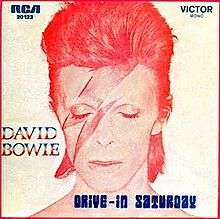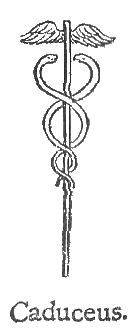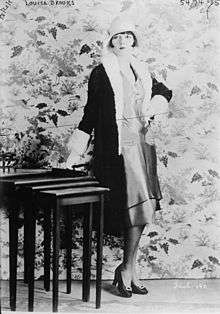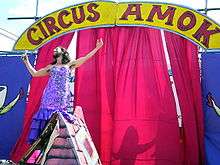Androgyny
| Part of a series on |
| Transgender topics |
|---|
 |
| Identities |
| Topics |
| Attitudes |
| Legal issues |
| Lists |
|
|
Androgyny is the combination of masculine and feminine characteristics. Gender ambiguity may be found in fashion, gender identity, sexual identity, or sexual lifestyle. It can also refer to one's singing or speaking voice.[1]
Etymology
Androgyny as a noun came into use c.1850, nominalizing the adjective androgynous. The adjective use dates from the early 17th century and is itself derived from the older French (14th Century) and English (c.1550) term androgyne. The terms are ultimately derived from Ancient Greek: ἀνδρόγυνος, from ἀνήρ, stem ἀνδρ- (anér, andr-, meaning man) and γυνή (gunē, gyné, meaning woman) through the Latin: androgynus,[2] The older word form androgyne is still in use as a noun with an overlapping set of meanings.
History
Androgyny among humans – physical, psychological, and cultural – is attested to from earliest history and across world cultures. The ancient Greek myth of Hermaphroditus and Salmacis, two divinities who fused into a single immortal – provided a frame of reference used in Western culture for centuries.
Androgyny and homosexuality are seen in Plato’s Symposium in a myth that Aristophanes tells the audience.[3] People used to be spherical creatures, with two bodies attached back to back who cartwheeled around. There were three sexes: the male-male people who descended from the sun, the female-female people who descended from the earth, and the male-female people who came from the moon. This last pairing represented the androgynous couple. These sphere people tried to take over the gods and failed. Zeus then decided to cut them in half and had Apollo stitch them back together leaving the navel as a reminder to not defy the gods again. If they did, he would cleave them in two again to hop around on one leg. Plato states in this work that homosexuality is not shameful. This is one of the earlier written references to androgyny. Other early references to androgyny include astronomy, where androgyn was a name given to planets that were sometimes warm and sometimes cold.[4]
Philosophers such as Philo of Alexandria, and early Christian leaders such as Origen and Gregory of Nyssa, continued to promote the idea of androgyny as humans' original and perfect state during late antiquity.”[5] In medieval Europe, the concept of androgyny played an important role in both Christian theological debate and Alchemical theory. Influential Theologians such as John of Damascus and John Scottus Eriugena continued to promote the pre-fall androgyny proposed by the early church fathers, while other clergy expounded and debated the proper view and treatment of contemporary “hermaphrodites.”[5]
Western Esotericism’s embrace of androgyny continued into the modern period. A 1550 anthology of Alchemical thought De Alchemia included the influential Rosary of the Philosophers, which depicts the sacred marriage of the masculine principle (Sol) with the feminine principle (Luna) producing the “Divine Androgyne,” a representation of Alchemical Hermetic beliefs in dualism, transformation, and the transcendental perfection of the union of opposites.[6] The symbolism and meaning of androgyny was a central preoccupation of the German mystic Jakob Böhme and the Swedish philosopher Emanuel Swedenborg. The philosophical concept of the “Universal Androgyne” (or “Universal Hermaphrodite”) – a perfect merging of the sexes that predated the current corrupted world and/or was the utopia of the next – also played a central rile in Rosicrucian doctrine[7] and in philosophical traditions such as Swedenborgianism and Theosophy. Twentieth Century Architect Claude Fayette Bragdon expressed the concept mathematically as a magic square, using it as building block in many of his most noted buildings.[8]
Fashion history
Throughout most of Western history, society has created rules to restrict people to dress according to their gender. Society have defined trousers as men’s clothing and women would be frowned upon to wear trousers.[9] However, during the 1800s, female spies were introduced and Vivandières wearing a certain uniform with a dress over trousers. Women activists during that time would also decide to wear trousers, for example Luisa Capetillo, a women’s right activist and the first women in Puerto Rico who wore trousers in public for the first time.[10]

By the early 1900s, there was a prominent blur of traditional gender roles that emerged with the World War I, and pants were being introduced in fashion by fashion pioneers such as Paul Poiret and Coco Chanel. Not only flappers were all the rage, it was also accompanied by a chic bob which gave women an androgynous look.[11] Coco Chanel, who has a love for wearing trousers herself stepped in and introduced the beach pajamas and designed horseback riding trousers for women.[9] During the 1930s, glamorous actresses such as Marlene Dietrich fascinated and shocked many with her strong desire to wear trousers and adopt the androgynous style. She is not only a style icon for the androgynous, but she is also remembered as one of the first actresses to wear trousers in a premiere.[12]

Throughout the 1960s and 1970s, the women’s liberation movement, sexual liberation and the Stonewall riots that was happening during the time was believed to have contributed to how fashion was and influenced fashion designers, such as Yves Saint Laurent.[13] Yves Saint Laurent designed the Le Smoking suit and first introduced in 1966, and Helmut Newton’s erotized androgynous photographs of it made Le Smoking iconic and classic.[14] The Le Smoking tuxedo was a controversial statement of femininity and has revolutionized trousers.
Elvis Presley, however is considered to be the one who introduced the androgynous style in rock'n'roll and made it the standard template for rock'n'roll front-men since the 1950s.[15] His pretty face and use of eye makeup often made people think he was a rather "effeminate guy",[16] but Elvis Presley was considered as the prototype for the looks of rock'n'roll.[15] The Rolling Stones, says Mick Jagger became androgynous " straightaway unconsciously" because of him.[16]
However, the upsurge of androgynous dressing for men really began after during the 60s and 70s. When the Rolling Stones played London’s Hyde Park in 1969, Mick Jagger wore a white ‘man’s dress’ designed by British designer Mr Fish.[17] Mr Fish, also known as Michael Fish, was the most fashionable shirt-maker in London, the inventor of ‘the Kipper tie’, and a principal taste-maker of ‘the Peacock revolution’ in men’s fashion. His creation for Mick Jagger was considered to be the epitome of the swinging 60s.[18] From then on, the androgynous style was being adopted by many celebrities.

During the 1970s, Jimi Hendrix was wearing high heels and blouses quite often, and David Bowie presented his alter- ego Ziggy Stardust, a character that was a symbol of sexual ambiguity when he launched the album ‘The Rise and Fall of Ziggy Stardust and Spiders from Mars’.[19] This was when androgyny entered the mainstream in the 70s and had a tremendous influence in pop culture. Another major influence during this time included John Travolta, one of the androgynous male heroes of the post-counter-culture disco era in the '70s, who starred in Grease and Saturday Night Fever.[20]
Continuing into the 1980's, the rise of avant-garde fashion designers like Yohji Yamamoto,[21] challenge the social constructs around gender during this time. Reinvigorating androgyny in fashion more so than it has been, addressing issues to do with gender. This is also reflected within pop culture icons during the 1980's like the luminous and vibrant David Bowie continuing his career through the 80s and further developing Ziggy.
Power dressing for women became even more prominent within the 1980s which was typically only something done by men in order to look structured and powerful. However during the 1980's this began to take a turn as women were entering jobs with equal roles to the men. In the article “The Menswear Phenomenon” by Kathleen Beckett written for Vogue in 1984 the concept of power dressing is explored as women entered these jobs they had no choice but to tailor their wardrobes according, eventually leading the ascension of power dressing as a popular style for women.[22] Women begin to find through fashion they can incite men to pay more attention to the seduction of their mental prowess rather, than the physical attraction of their appearance. This influence in the fashion world quickly makes its way to the world of film, with movies like "Working Girl" using power dressing women as their main subject matter.

Androgynous fashion made its most powerful in the 1980s debut through the work of Yohji Yamamoto and Rei Kawakubo, who brought in a distinct Japanese style that adopted distinctively gender ambiguous theme. These two designers consider themselves to very much a part of the avant-garde, reinvigorating Japanism..[23] Following a more anti-fashion approach and deconstructing garments, in order to move away from the more mundane aspects of current Western fashion. This would end up leading a change in Western fashion in the 1980's that would lead on for more gender friendly garment construction. This is because designers like Yamamoto believe that the idea of androgyny should be celebrated, as it is an unbiased way for an individual to identify with ones self and that fashion is purely a catalyst for this.
Also during the 80s, Grace Jones’s a famous singer and fashion model gender-thwarted appearance in the ’80s which startled the public, but her androgynous style of heavily derivative of power dressing and eccentric personality has inspired many, and has become an androgynous style icon for modern celebrities.[24] This was seen as controversial but from then on, there was a rise of unisex designers later in the 1990s and the androgynous style was widely adopted by many.
Symbols and iconography

In the ancient and medieval worlds, androgyny and hermaphrodites were represented in art by the caduceus, a wand of transformative power in ancient Greco-Roman mythology. The caduceus was created by Tiresias and represents his transformation into a woman by Juno in punishment for striking at mating snakes. The caduceus was later carried by Hermes/Mercury and was the basis for the astronomical symbol for the planet Mercury and the botanical sign for hermaphrodite. That sign is now sometimes used for transgender people.
Another common androgyny icon in the medieval and early modern period was the Rebis, a conjoined male and female figure, often with solar and lunar motifs. Still another symbol was what is today called sun cross, which united the cross (or saltire) symbol for male with the circle for female.[25] This sign is now the astronomical symbol for the planet Earth.[26]
 Mercury symbol derived from the Caduceus |
 A Rebis from 1617 |
 "Rose and Cross" Androgyne symbol |
 Alternate "rose and cross" version |
Gender identity
For humans, androgyne (/ˈændrədʒaɪn/ AN-drə-jyn) in terms of gender identity is a person who does not fit neatly into the typical masculine and feminine gender roles of their society. Androgynes may also use the term "ambigender" or "polygender" to describe themselves. Many androgynes identify as being mentally between woman and man. They may identify as "non-gender", "gender-neutral", "agender", "between genders", "genderqueer", "non-binary", "multigender", "intergendered", "pangender" or "gender fluid".[27] however these terms are slightly different in definition. A person who is androgynous may engage freely in what is seen as masculine or feminine behaviors as well as tasks. They have a balanced identity that includes the virtues of both genders and may disassociate the task with what gender it may be socially or physically assigned to.[28] People who are androgynous disregard what traits are culturally constructed specifically for males and females within a specific society, and rather focus on what behavior is most effective within the situational circumstance.[28]
Bem Sex-Role Inventory
The Bem Sex-Role Inventory (BSRI) was constructed by the early leading proponent of androgyny, Sandra Bem (1977).[29] The BSRI is one of the most widely used gender measures. Based on an individual's responses to the items in the BSRI, they are classified as having one of four gender role orientations: masculine, feminine, androgynous, or undifferentiated. Bem understood that both masculine and feminine characteristics could be expressed by anyone and it would determine those gender role orientations.[30]
An androgynous person is a female or male who has a high degree of both feminine (expressive) and masculine (instrumental) traits. A feminine individual is ranked high on feminine (expressive) traits and ranked low on masculine (instrumental) traits. A masculine individual is ranked high on instrumental traits and ranked low on expressive traits. An undifferentiated person is low on both feminine and masculine traits.[29]
Gender and behavior
Lesbians who do not define themselves as butch or femme may identify with various other labels including "androgynous" or "andro" for short. A few other examples include "tomboy" and "tom suay", which is Thai for 'beautiful butch'. Some lesbians reject gender performativity labels altogether and resent their imposition by others. Note that androgynous and butch are often considered equivalent definitions, though less so in the butch/femme scene.
The recently coined word genderqueer is often used to refer to androgyny, but the terms "genderqueer" and "androgyny" (or "androgynous") are neither equivalent nor interchangeable. "Genderqueer" is not specific to androgynes. It does not denote gender identity and may refer to any person, cisgender or transgender, whose behavior falls outside conventional gender norms. Furthermore, "genderqueer", by virtue of its ties with queer culture, carries sociopolitical connotations that androgyny does not carry. For these reasons, some androgynes may find the label "genderqueer" inaccurate, inapplicable, or offensive. "Androgneity" is a viable alternative to "androgyny" for differentiating internal (psychological) factors from external (visual) factors.[31]
Terms such as "bisexual", "heterosexual", and homosexual have less meaning for androgynes who do not identify as men or women to begin with. Infrequently the words gynephilia and androphilia are used, and some describe themselves as androsexual. These words refer to the gender of the person someone is attracted to, but do not imply any particular gender on the part of the person who is feeling the attraction.

According to Sandra Bem, androgynous men and women are more flexible and more mentally healthy than either masculine or feminine individuals; undifferentiated individuals are less competent.[29] More recent research has debunked this idea, at least to some extent, and Bem herself has found weaknesses in her original pioneering work. Now she prefers to work with gender schema theory.
To a degree, context influences which gender role is most adaptive. In close relationships, a feminine or androgynous gender role may be more desirable because of the expressive nature of close relationships. However, a masculine or androgynous gender role may be more desirable in academic and work settings because of the demands for action and assertiveness.
One study found that masculine and androgynous individuals had higher expectations for being able to control the outcomes of their academic efforts than feminine or undifferentiated individuals.[33]
Culture
To say that a culture or relationship is androgynous is to say that it lacks rigid gender roles and that the people involved display characteristics or partake in activities traditionally associated with the other sex. The term "androgynous" is often used to refer to a person whose look or build make determining their gender difficult, but is generally not used to describe actual intersexuality, transgender, or two-spirit people. Occasionally, people who do not actually define themselves as androgynes adapt their physical appearance to look androgynous. This outward androgyny has been used as a fashion statement and some of the milder forms (women wearing men's trousers/men wearing skirts, for example) are not perceived as transgender behavior.
Physical traits
Androgynous traits are those that either have no gender value or have some aspects generally attributed to the opposite gender. Physical androgyny. Some intersex and non-intersex people may exhibit androgynous physical traits. This is distinct from androgyny, which concerns personal and social anomalies in gender, and is also distinct from psychological androgyny, which is a matter of gender identity.[27]
Alternatives
An alternative to androgyny is gender-role transcendence: the view that individual competence should be conceptualized on a personal basis rather than on the basis of masculinity, femininity, or androgyny.[34]
In agenderism, the division of people into women and men (in the psychical sense), is considered erroneous and artificial.[35]
Contemporary trends

Androgyny has been gaining more prominence in popular culture in the early 21st century.[36] Both fashion industries[37] and pop culture have accepted and even popularised the "androgynous" look, with several current pop stars being hailed as creative trendsetters.
The rise of the metrosexual in the first decade of the 2000s has also been described as a related phenomenon associated with this trend. Traditional gender stereotypes have been challenged and reset in recent years dating back to the 1960s, the hippie movement and flower power. Artists in film such as Leonardo DiCaprio sported the "skinny" look in the 1990s, a departure from traditional masculinity which resulted in a fad known as "Leo Mania."[38] This trend came long after musical superstars such as David Bowie, Boy George, Prince, and Annie Lennox challenged the norms in the 1970s and had elaborate cross gender wardrobes by the 1980s. Musical stars such as Marilyn Manson and the band Placebo have used clothing and makeup to create an androgyny culture throughout the 1990s and the first decade of the 2000s.[39] Manson even appeared genderless in the album cover for Mechanical Animals, showing breasts and no reproductive organs.
While the 1990s unrolled and fashion developed an affinity for unisex clothes there was a rise of designers who favored that look, like Helmut Lang, Giorgio Armani and Pierre Cardin, the trends in fashion hit the public mainstream in the 2000s (decade) that featured men sporting different hair styles: longer hair, hairdyes, hair highlights. Men in catalogues started wearing jewellery, make up, visual kei, designer stubble. These styles have become a significant mainstream trend of the 21st century, both in the western world and in Asia.[42] Japanese and Korean cultures have featured the androgynous look as a positive attribute in society, as depicted in both K-pop, J-pop,[43] in anime and manga,[44] as well as the fashion industry.[45]
See also
References
- ↑ 蘇打綠 sodagreen -【The Lonely Goatherd+山頂黑狗兄】Official Music Video
- ↑ "Online Etymology Dictionary: androgynous". Retrieved 13 July 2013.
- ↑ The Symposium: and, The Phaedrus; Plato's erotic dialogues. Translated and with introduction and commentaries by William S. Cobb. Albany: State University of New York Press. 1993. ISBN 978-0-7914-1617-4.
- ↑ "Androgyn". University of Michigan Library. Retrieved 1 April 2015.
- 1 2 van der Lugt, Maaike, “Sex Difference in Medieval Theology and Canon Law,” Medieval Feminist Forum (University of Iowa) vol. 46 no. 1 (2010): 101–121
- ↑ Dennis William Hauck, The Complete Idiot’s Guide to Alchemy (New York: Penguin, 2008), 241
- ↑ William Wallace Atkinson, The Secret Doctrines of the Rosicrucians (London: L.N. Fowler & Co., 1918), 52-61.
- ↑ Ellis, Eugenia Victoria (June 2004). “Geomantic Mathematical (re)Creation: Magic Squares and Claude Bragdon's Theosophic Architecture”. Nexus V: Architecture and Mathematics: 79-92.
- 1 2 Ewing, E.; Mackrell, A. (2002). History of Twentieth Century Fashion. L.A: Quite Specific Media Group Ltd.
- ↑ Valle-Ferrer, Norma (2006-06-01). Luisa Capetillo, Pioneer Puerto Rican Feminist: With the collaboration of students from the Graduate Program in Translation, The University of Puerto Rico, Río Piedras, Spring 1991. Peter Lang Publishing Inc. ISBN 9780820442853.
- ↑ Köksal, Duygu; Falierou, Anastasia (2013-10-10). A Social History of Late Ottoman Women: New Perspectives. BRILL. ISBN 9789004255258.
- ↑ "Harriet Fisher". The Queen of Androgyny – Marlene Dietrich – Blog. Retrieved 2016-05-22.
- ↑ Commentator, Sally Kohn, CNN Political. "The Seventies: The sex freakout". CNN. Retrieved 2016-05-22.
- ↑ Moet, Sophie (2014-05-01). "Androgyny and Feminism". Sophie Moet. Retrieved 2016-05-22.
- 1 2 "Elvis Never Gets Credit for One of His Greatest Gifts to Rock 'n Roll". Observer. 2016-01-08. Retrieved 2016-05-23.
- 1 2 Daniel, Pete (2000-01-01). Lost Revolutions: The South in the 1950s. Univ of North Carolina Press. ISBN 9780807848487.
- ↑ Baker, Lindsay. "His or hers: Will androgynous fashion catch on?". www.bbc.com. Retrieved 2016-05-22.
- ↑ "Mick Jagger's white dress cast him as a romantic hero". Telegraph.co.uk. Retrieved 2016-05-22.
- ↑ Lalovic, Itana (2013-11-19). "Androgyny in the fashion world". Wall Street International. Retrieved 2016-05-22.
- ↑ Rehling, Nicola (2010-06-21). Extra-Ordinary Men: White Heterosexual Masculinity and Contemporary Popular Cinema. Lexington Books. ISBN 9781461633426.
- ↑ "Global Influences: Challenging Western Traditions". London: Berg.
- ↑ "The Menswear Phenomenon.". Vogue; Conde Nast.
- ↑ "Global Influences: Challenging Western Traditions.". London: Berg.
- ↑ "Androgynous Fashion Moments". Highsnobiety. 2015-05-14. Retrieved 2016-05-23.
- ↑ William Wallace Atkinson, The Secret Doctrines of the Rosicrucians (London: L.N. Fowler & Co., 1918), 53-54.
- ↑ http://solarsystem.nasa.gov/galleries/solar-system-symbols|accessed February 23, 2016
- 1 2 "Definition of androgynous: Dictionary and Thesaurus". Retrieved 13 July 2013.
- 1 2 Woodhill, Brenda; Samuels, Curtis (2004). "DESIRABLE AND UNDESIRABLE ANDROGYNY: A PRESCRIPTION FOR THE TWENTY-FIRST CENTURY". Journal of Gender Studies.
- 1 2 3 Santrock, J. W. (2008). A Topical Approach to Life-Span Development. New York, NY: The McGraw-Hill Companies. 007760637X
- ↑ DeFrancisco, Victoria L. (2014). Gender in Communication. SAGE Publications. p. 11. ISBN 978-1-4522-2009-3.
- ↑ "Psychological Androgyny -- A Personal Take". Retrieved 13 July 2014.
- ↑ New world coming: the 1920s and the making of modern America. New York: Scribner, 2003, p. 253, ISBN 978-0-684-85295-9.
- ↑ Choi, N. (2004). Sex role group differences in specific, academic, and general self-efficacy. Journal of Psychology, 138, 149–159.
- ↑ Pleck, J. H. (1995). The gender-role strain paradigm. In R. F. Levant & W. S. Pollack (Ed.s), A new psychology of men. New York: Basic Books.
- ↑ Butler, Judith P. (1993). Bodies that Matter: On the Discursive Limits of 'Sex'. New York: Routledge. pp. 2–3. Retrieved 12 Oct 2014.
- ↑ "Androgyny becoming global?". uniorb.com. Archived from the original on 26 December 2010. Retrieved 17 December 2010.
- ↑ Wendlandt, Astrid. "Androgynous look back for spring". Reuters. Retrieved 17 December 2010.
- ↑ Peter Hartlaub (February 24, 2005). "The teenage fans from 'Titanic' days jump ship as Leonardo DiCaprio moves on". sfgate.com. Retrieved 17 December 2010.
- ↑ Cavendish, Marshall (2010). Sex and Society, Vol 1. Paul Bernabeo. p. 69.
- ↑ "Move over, Psy! Here comes G-Dragon style". The Independent. 2014-08-17. Retrieved 2015-04-05.
- ↑ "K-pop: a beginner's guide". The Guardian. 2014-03-03. Retrieved 2015-04-05.
- ↑ "Androgynous look catches on". The Himalayan Times. September 13–16, 2010. Retrieved 17 December 2010.
- ↑ "Harajuku Girls Harajuku Clothes And Harajuku Gothic fashion Secrets". Tokyo Top Guide. Retrieved 17 December 2010.
- ↑ "Profile of Kagerou". jpopasia.com. Retrieved 17 December 2010.
- ↑ Webb, Martin (13 November 2005). "Japan Fashion Week in Tokyo 2005. A stitch in time?". The Japan Times. Retrieved 17 December 2010.
External links
| Look up androgyny in Wiktionary, the free dictionary. |
| Wikimedia Commons has media related to Androgyny. |
- Androgyny: study and collection of articles
- Androgyne Online
- Sandra Bem and androgyny
- The Two-Spirit Tradition

